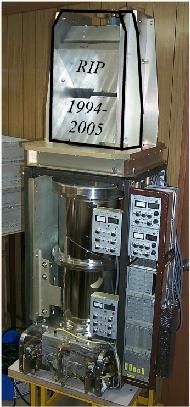Memories of the Mopra 3-mm SIS receiver
 The old Mopra receiver. Photo: Graeme Carrad
The old Mopra receiver. Photo: Graeme Carrad It was the end of an era when on 13 September 2005 the Mopra SIS receiver and its two-stage compressor were decommissioned and replaced by the brand new Mopra 3/12-mm receiver and its compressor. The cheers of astronomers who hated tuning the SIS receiver could be heard from as far away as the University of New South Wales (UNSW) but the SIS receiver has proved to be a useful beastie nonetheless. Its operation was complicated by the need for cooling to 3.5 Kelvin but considering it was installed in mid-1994 it has done sterling service.
John Whiteoak embraced the SIS receiver and put it to its best use. Under him it served as a collector of data for PhD students as well as for his own research. He pushed the limits of the observing range (83.5 – 116 GHz) as well as pushing the limits of use by observing well outside the accepted "millimetre observing period" that spans only the winter months. Mike Kesteven did much to ensure the Mopra software kept ticking over and contributed immensely to the knowledge of beam shape, efficiencies and where the sub-reflector should be. Later years have seen UNSW making most use of it and their "Friend of Mopra" scheme and recording of tuning settings made the need for outside support minimal.
The automation that allowed tuning from the control room at Mopra was not available in the early years of operation and more than once a bedroom at the site's building or a tent on the grass on the other side of the site fence was the home for a receiver group member who would be woken to re-tune in the middle of the night. The automation didn't stop the call outs completely but problems could be resolved remotely.
Its construction by Graham Moorey, Russell Bolton, Simon Hoyle, Pat Sykes, Mark Bowen, Peter Seckold and Les Reilly all those years ago was quite an accomplishment. The SIS mixers have never failed and the electronics in general have been most reliable. It is just as well as there never were any spare mixers. Most downtime was attributed to cryogenic maintenance but ironically in this last season there were no faults at all. The two-stage scroll compressor developed in the receiver group now serves as the model for those to be used on the ALMA array in Chile.
Its folded optics arrangement has undergone various changes firstly to allow turret rotation and then to facilitate illumination of the full surface of the dish and all the while the most precious part — the polarising grids — have survived. Their destruction would have stopped all operation of the receiver.
Coonabarabran and in particular "the big China" and Imperial Hotel have benefited from the receivers' presence and the untiring assistance from the Narrabri staff though some in the town may wish to dispute how much benefit ATNF staff brought and whether it was more of a "cost neutral" arrangement. Mopra Rock has had more than its fair share of climbers in this time as well.
The main function of the equipment was an odd one however. Receiver installation normally acted as a drought breaker so farmers would crack a smile as Jack, and more recently Mick, drove the CSIRO air ride truck along Timor road knowing that rain was on the way to spoil observations. The new receiver has continued the tradition and the first day that measurements were to be undertaken at the end of the first installation week the rain came and hung around ensuring the memories of drips down the back of the neck in cold weather live on.
Graeme.Carrad
(Graeme.Carrad@csiro.au)
